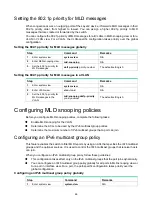
68
To enable dropping unknown IPv6 multicast data for a VLAN:
Step Command
Remarks
1.
Enter system view.
system-view
N/A
2.
Enter VLAN view.
vlan vlan-id
N/A
3.
Enable dropping unknown
IPv6 multicast data for the
VLAN.
mld-snooping drop-unknown
By default, this feature is disabled.
Unknown IPv6 multicast data is
flooded in the VLAN to which the
data belongs.
Enabling MLD report suppression
This feature enables the switch to forward only the first MLD report for an IPv6 multicast group to its
directly connected Layer 3 device. Other reports for the same group within the same query interval
are discarded. This reduces the multicast traffic.
To enable MLD report suppression:
Step Command
Remarks
1.
Enter system view.
system-view
N/A
2.
Enter MLD-snooping view.
mld-snooping
N/A
3.
Enable MLD report
suppression.
report-aggregation
By default, MLD report
suppression is enabled.
Setting the maximum number of IPv6 multicast groups on a
port
You can set the maximum number of IPv6 multicast groups on a port to regulate the port traffic.
Configuration restrictions and guidelines
When you set the maximum number of IPv6 multicast groups on a port, follow these restrictions and
guidelines:
•
This configuration takes effect only on the IPv6 multicast groups that the port joins dynamically.
•
If the number of IPv6 multicast groups on a port exceeds the limit, the system removes all the
forwarding entries related to that port. In this case, the receiver hosts attached to that port can
join IPv6 multicast groups again before the number of IPv6 multicast groups on the port reaches
the limit.
Configuration procedure
To set the maximum number of IPv6 multicast groups on a port:
Step Command
Remarks
1.
Enter system view.
system-view
N/A
2.
Enter Layer 2 Ethernet
interface view or Layer 2
aggregate interface view.
interface interface-type
interface-number
N/A
3.
Set the maximum number of
IPv6 multicast groups on a
port.
mld-snooping group-limit
limit
[
vlan vlan-list
]
The default setting is
4294967295.






























